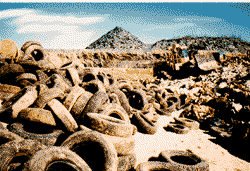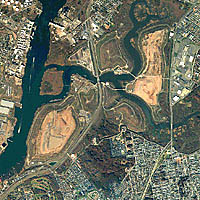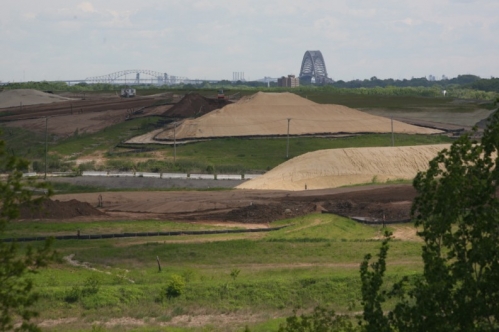So silly in fact that the price of the book has fallen from $20 to $2.39.
http://www.amazon.com/Contract-Earth-Newt-Gingrich/dp/0801887801
This from a man who does not believe in global warming. This from a man who helped start the “Drill Here, Drill Now” movement. This from a man who adamitly opposes Cap and Trade even though it’s an industry ameliorative. Oh and a forward by the man who once hypothesized that people with black skin have lower I.Q.s then people with white skin color. But don’t listen to me:
http://www.amazon.com/review/product/0801887801
|
7 of 8 people found the following review helpful:
 If we pass the test, we get to keep the planet (Everglades), December 6, 2007 If we pass the test, we get to keep the planet (Everglades), December 6, 2007
Local Book Review by John Arthur Marshall, (JAMinfo@AOL.com); President
Arthur R. Marshall Foundation and Florida Environmental Institute, Inc. www.ArtMarshall.org
A Contract with the Earth: Newt Gingrich and Terry Maple; John Hopkins; 2007
Contract with the Earth is an overdue call for local, national and international action in a time of serious need for we planetary occupants to pay much more attention to what we are doing to the planet (destroying our life support system at a seemingly indiscernible rate, with enormous consequences given ubiquitous inaction). This is the major problem that Contract addresses.
Contract might be summarized as a re-call of Teddy Roosevelt conservationism with emphasis on the authors’ new advocacy of entrepreneurial environmentalism. All this verges on a matter of insistence, which is good, even great, if twice as many folks that are engaged in the present environmental movement read and heed… Then engage at least one neo-conservationist politician on the need to take on stewardship of the environment as a major issue in the current election debates. We can do it!
As the authors astutely note: Everyone ought to participate in discussions of environmental policies and to that end should have a rudimentary understanding of the processes that make a habitable planet.
Of particular importance in the current elections scenario, the authors identify the need to get the environment elevated as arguably the most important issue confronting society today. How can presidential candidates not pay attention to long-term effects of climate change, and the need for conservation and preservation of what remains of our life support system? A bonus is a call for strategic planning, and adherence to planetary needs.
The authors acknowledge that insufficient attention is being paid by politicians, and with the rest of us, lament that the current administration has been a failure here, even with the late attempt at for lasting legacy to cover inaction regarding potential disastrous consequences in the future.
The author’s define the distinction between conservation and preservation in a manner that deserves further consideration. That is left for future readers to discover, in a book that is worth reading, and begging for action by the non-reactive information-overloaded majority.
As President of a tree-planting organization, my most favorite spot in this book is Chapter 8: Renewing the Natural World. This chapter emphasizes the need to preserve rainforests and restore forests and wetlands. Here in Florida we call them forested wetlands, or swamps (lots of cypress and custard apple trees and related species normally in standing water). In the sequence of quotable quotes at the beginning of each chapter, Chapter 8 also holds my favorite quote:
Few are altogether deaf to the preaching of pine trees. Their sermons on the mountains go to our hearts; and if people in general could be got into the woods, even for once to hear the trees speak for themselves, all difficulties in the way of forest perseveration would vanish. John Muir [Founder Sierra Club]; there were also lots of pine trees in Florida. The past-tense is not good.
This quote is an appropriate sequel to another salient section in Chapter 10, with the mention of Richard Louv, author of Last Child in the Woods. Louv amplifies the need for the younger generation to be more exposed to nature, as previous generations were. Something is missing. Louv points out that staying indoors in front of a computer, rather than more exposure to nature, may lead to nature deficit disorder, which he relates to potential attention deficit disorder and maladjustments in life.
As a sixth generation Floridian, following progress of the Comprehensive Everglades Restoration Plan (CERP) I very much appreciate Newt’s observation on page 226:
“Florida has the opportunity to become a laboratory that the entire world studies… There are very few places where you have a complex fragile ecosystem this close to this many people”. Newt, Associated Press, 1997. Recent AP headlines – Everglades Restoration bogged down – is inappropriate.
The authors also recognize that the proximity of massive land-fills (Mt. Trashmore’s we call them) to the Everglades are inappropriate to conservation and preservation of important ecosystems. Currently, local government is considering locating a Mt. Trashmore right next to the Arthur R. Marshall National Wildlife Refuge, a primary subject of CERP implementation. Not only will the landfill be a dominant terrain feature, the creatures this will attract will pose a serious threat to native wildlife, especially wading birds. This could also pose a serious threat to federal funding.
The authors also implore us (again!) to think globally and act locally. OK Palm Beachers, CERP implementation is also about sustaining a viable water supply. This is need to know stuff.
Unfortunately the behavior of government toward CERP, especially in the current federal administration, is much like the authors describe:
The American government, however continues to posture and vent, unable or unwilling to commit or act decisively…. Except possibly to give development overwhelming priority.
If there is one thing that might call for a little reconsideration, it is the authors’ inclination to view technological solutions as sometimes preferable to natural one’s, without mentioning the precautionary principle, an approach advocated by scientists when there is a dearth of knowledge. Scientists caution on reliance of engineered solutions, as there are always unforeseen, usually adverse consequences here. Humankind’s intrusions require natural solutions. Natural solutions are most often perpetual, and the most cost-effective. OK, green energy may be an exception.
At the onset, Contract challenges the readers to take a Test to determine whether (or not) you (the reader) is a mainstream environmentalist. In the end the authors challenge the readers to support the broad principles of the contract, by contributing time and ideas to create together a new kind of environmental movement.
From the Everglades Restoration endeavor, a more widely applicable quote is attributed to the Mother of the Everglades, Marjory Stoneman Douglas, author of Everglades, River of Grass:
If we pass the Test we get to keep the planet!
DISCLAIMER: The Author of this review, an Everglades restoration advocate, is not a professional book reviewer.
John Arthur Marshall
2806 South Dixie Highway, WPB 33405; 561-801-2165
|
:}
On the other hand:
Same old, same old, April 18, 2008
A lot of rehash of old ideas and trite science. I was disappointed, especially since I have been a big fan of Newt’s philosophies and politics.
:}
If you want to hear what the great man himself thinks try, are you ready for it?, newt.org:
http://newt.org/AContractwiththeEarth/tabid/220/Default.aspx
:}
Scientist Fred Bortz sees it a little different:
http://www.fredbortz.com/review/ContractWithEarth.htm
I am a scientist, and I vote. To put this review in context, I place myself in the moderate to progressive segment of American politics. But I never let my political views get in the way of interpreting what observation, experiment, and scientific analysis tell me about the world.
For instance, when I reviewed Chris Mooney’s provocative The Republican War on Science (RWOS), my first reaction was skepticism. “Show me the evidence,” I demanded of that book. In the end, Mooney’s thorough research persuaded me that his thesis deserved serious consideration.
RWOS covered a broad range of topics, but the one of greatest concern to me was the political foot-dragging and outright denial of human-induced global warming, especially in the Republican controlled congress and the George W. Bush White House.
I often wrote in my blog that I would listen to any proposed political solution to the problem–liberal, conservative, or otherwise–as long as the discussion began with the best understanding of the science and considered a range of plausible scenarios. Thus I was heartened to learn of this new book by one of the United States leading conservative thinkers, Newt Gingrich, in collaboration with conservationist Terry Maple.
I assumed that I would disagree with Gingrich’s proposed political approaches. But I also assumed that the book will make an important contribution to the debate on global warming. I was correct on both counts. A Contract With the Earth has the potential to move the debate away from whether global warming is occurring and whether human activities are causing it, and move toward issues where conservatives and liberals argue about how best to deal with the problem.
However, I am disappointed that it pussyfoots around the Right’s nonsense about calling global warming a hoax and a liberal conspiracy. Gingrich frequently points fingers at the Left for their “doomsday scenarios.” I disagree with that characterization, though I understand that a warning can be delivered too stridently, thereby turning off the people you hope to reach.
But if turning people away from the solution is a problem, then Gingrich needs to be equally critical of outright denialism on the Right. To deny and obfuscate is far more than simply to “disdain” environmental action, which is about as far as he goes in criticizing his own party. He may not have agreed with leading denier Senator James Inhofe of Oklahoma, but by remaining quiet he facilitated Inhofe’s misuse of his Chairmanship of the Senate Committee on Environment and Public Works to block action on global warming. In this book, Gingrich is continuing to give Inhofe and his cronies a pass.
In other words, I don’t doubt his sincerity about the need to act, and I don’t question the value of conservative approaches to the solution. But Gingrich is clearly worried about his right flank in this book. Mainstream Republicans have known for some time that global warming is a problem and would welcome some courageous leadership from Gingrich. Instead, many of them will see this as opportunism by someone who wants to be president and thus can’t afford to alienate the Right.
Physicist Fred Bortz is the author of numerous science books for young readers.
:}
Leave it to the Washington Post to get it right:
http://www.powells.com/review/2008_01_04.html
Green Republicans
A review by Juliet Eilperin
Yet they gloss over some of the toughest questions facing international policymakers today, and they compare the environmental records of Bush and former President Bill Clinton in a way that strains credulity.
On the central question of global warming, Gingrich and Maple are closer to Bush than to most of the world’s business and political leaders. They argue that climate change poses a serious threat and that the United States should reengage in international negotiations. But they question the wisdom of imposing a mandatory, nationwide cap on carbon emissions on the grounds that Europe’s carbon dioxide emissions rose faster than America’s between 2000 and 2004. (It’s worth noting that since 2000, U.S. emissions have risen at 1.5 times the rate they did in the 1990s, not exactly a stunning model of restraint.) Like Bush, Gingrich and Maple rest their hopes on technological innovation: “The world can be changed faster by the spread of brilliant ideas than by any plodding bureaucracy, and we gladly put our faith in such intellectual and social processes.”
In that sense this book is classic Newt, brimming with military metaphors and grand visions of America leading the rest of globe to a brighter future. In environmentalism, as in war, “we must demand a complete and decisive victory,” the authors say. “Renewing the earth is surely one of the greatest challenges this generation has confronted, and we understand how important it is to succeed.”
To show the value of what they call “business partnerships on behalf of the environment,” the authors describe how the Nature Conservancy, Conservation International and the Wildlife Conservation Society have made common cause with such corporate entities as Wal-Mart and McDonald’s. As a result, much of the book reads like the kind of corporate advertisement that appears on newspaper op-ed pages. Gingrich and Maple contend that the private sector, not government, holds the answers to the globe’s biggest problems. The question is whether people in places such as Bangladesh can afford to wait and see if they’re right.
Juliet Eilperin is the Post‘s national environmental reporter.
:}
:}
![]() icon, you can sequentially visit each exhibit area. (Clicking on the
icon, you can sequentially visit each exhibit area. (Clicking on the ![]() icon will enable you to return to the previous page.) Please note that several activities, resources, and profiles are located at other web sites. After visiting them, click on your web browser’s “back” button to return to your place in the exhibition. Finally, if at any time you want to visit a different exhibit area, return to this page by clicking on the “home” garbage bag icon, and selecting the desired exhibit area below. Enjoy your visit!
icon will enable you to return to the previous page.) Please note that several activities, resources, and profiles are located at other web sites. After visiting them, click on your web browser’s “back” button to return to your place in the exhibition. Finally, if at any time you want to visit a different exhibit area, return to this page by clicking on the “home” garbage bag icon, and selecting the desired exhibit area below. Enjoy your visit!










